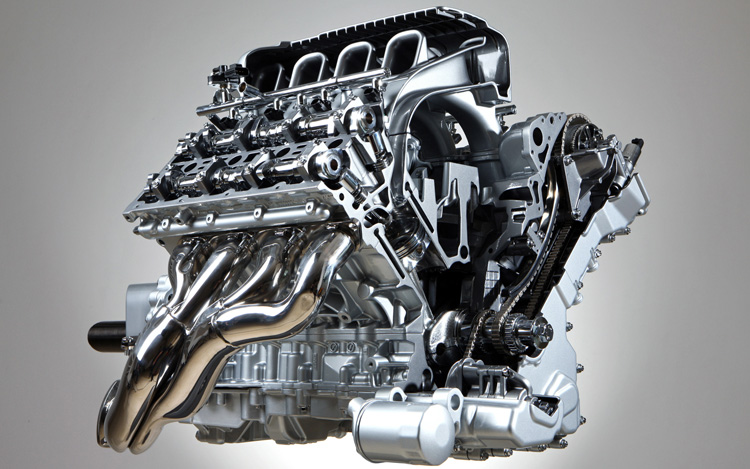After having moved the vehicle manufacturing plant to Gaydon’s modern factory, which produced 5,000 cars a year, the capacity and technology of the old engine division still based in Newport Pagnell was utterly insufficient.
In order to meet the new requirements, Aston Martin moved in October 2004 its engine design and manufacturing plant to Cologne, Germany. This would be the first time that Aston Martin had a factory dedicated exclusively to engine development.
This new 12,500 square meter plant would be located in a building adjacent to the Ford engine factory in the same city. The whole cycle, from design to final assembly would be performed within this same plant.
Each engine is hand-built by a single person and all engines are tested in the same facilities, with 30 people working in this area. All the engines have a plate signed by the person who was responsible for the assembly process.
The 2005 V8 Vantage would be the first V8 Aston Martin not using the engine designed by Tadek Marek, used for the first time in the 1969 DBS V8 and up to year 2000, with a last evolution which had a displacement of 5.3 liters and dual supercharger that delivered 600hp and 815Nm of torque. These figures made the V8 Vantage V600 the most powerful car that Aston Martin had ever produced up until the One-77 released in 2008.

The new V8 powerplant with internal code AM05, is based on the one used in early 21st century by Jaguar in its XK models. Aston Martin claims AM05 as its own design, proven that even the engine block has different specifications to those used by Jaguar engines, with further differences such as dry sump lubrication and a completely new head design.

Jeremy Main, Product Development Manager at Aston Martin, would say in the presentation of the V8 Vantage:
We share experience within the Ford Motor Co. group, but this design is completely new and not an engine shared with any other brands.
Each key component is exclusively manufactured [by Aston Martin] from block specification, to cylinder heads, crankshaft, connecting rods, pistons, camshafts, intake and exhaust manifolds, lubrication and even the electronic management. The V8 engine is an exclusive design by Aston Martin.
AM05 is fully alloy both block and cylinder heads. With 89x86mm bore and stroke it has a displacement of 4.3 liters, delivering 385hp at 7000rpm and a max torque of 410Nm from 5000rpm.
Aston Martin had chosen an intake design with short length ducts, thus favoring high rpm airflow in exchange for a relatively poor mid-range torque band. Likewise, the exhaust manifolds are also designed with high rpm performance in mind at the expense of low and mid range torque. To understand how the length of the exhaust affects the performance of the vehicle, I recommend reading this article.

Right before the V8 Vantage production was set to begin, Ford mandated that all models sold by Ford PAG (Premier Automotive Group) should be lead-less in any of their components. For this purpose, new crankshaft bearings were developed requiring the use of sintered conrods, while the conrods used during the development along with the lead bearings were made out of forged steel.
Shortly before the first units were sold, engine tests showed that those engines equipped with the new bearings were irreparably clogged within a few minutes of operation.
To be able to meet the deadlines, the first 1000 V8 Vantages used forged steel conrods and lead bearings, while in all subsequent engines sintered rods were used. Although it is well proven that the new connecting rods and bearings are perfectly reliable, the higher quality of the components makes these first 1000 engine batch the most desirable.
The AM05 specifications can be seen in the table below:
| Material | Full alloy block and heads |
| Fuel supply | Sequential indirect injection |
| Heads | Double overhead camshaft. 4 valves per cylinder. Variable intake timing. |
| Valves | Intake: 34.9mm. Exhaust: N/D |
| Intake valve timing | Open 46º before TDC, close 90º after BDC |
| Exhaust valve timing | Open 60º before BDC, close 75º after TDC |
| Bore | 89mm |
| Stroke | 86mm |
| Spark plugs | NGK–IFR7N-10 |
| Firing order | 1 – 5 – 4 – 2 – 6 – 3 – 7 – 8 |
| Spark plug gap | 0.9-1.0 mm |
| Compression ratio | 11.3:1 |
| Idle | 750rpm |
| Max horsepower | 385cv @ 7000rpm |
| Max torque | 410Nm @ 5000rpm |
| Redline | 7300rpm |
| Lubrication type | Dry sump |
| Oil | Castrol Edge Sport 10w-60 (10.4 litres) |
What actually makes this engine something special it’s the beautiful sound it produces

